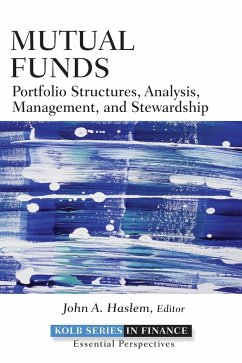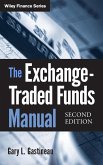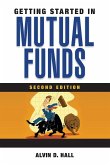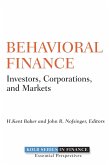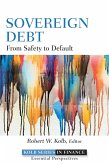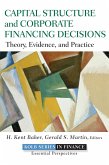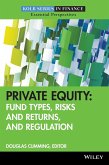Mutual Funds (Kolb series)
Herausgegeben von Haslem, John A.
Mutual Funds (Kolb series)
Herausgegeben von Haslem, John A.
- Gebundenes Buch
- Merkliste
- Auf die Merkliste
- Bewerten Bewerten
- Teilen
- Produkt teilen
- Produkterinnerung
- Produkterinnerung
An authoritative, must-read guide to making more informed decisions about mutual funds
Providing a balance of theory and application, this authoritative book will enable you to evaluate the various performance and risk attributes of mutual funds. It covers a broad range of topics, including understanding the advantages and disadvantages of mutual funds, evaluating stock/bond allocations within fund portfolios, assessing fund diversification risk, measuring fund returns and risk, and making fund buy/sell decisions.
While informative chapters combine clear summaries of existing research…mehr
Andere Kunden interessierten sich auch für
![Global Housing (Kolb series) Global Housing (Kolb series)]() Global Housing (Kolb series)78,99 €
Global Housing (Kolb series)78,99 €![The Exchange-Traded Funds Manual The Exchange-Traded Funds Manual]() Gary L. GastineauThe Exchange-Traded Funds Manual67,99 €
Gary L. GastineauThe Exchange-Traded Funds Manual67,99 €![Getting Started in Mutual Funds Getting Started in Mutual Funds]() Alvin D. HallGetting Started in Mutual Funds21,99 €
Alvin D. HallGetting Started in Mutual Funds21,99 €![Behavioral Finance Behavioral Finance]() Behavioral Finance79,99 €
Behavioral Finance79,99 €![Sovereign Debt Sovereign Debt]() Sovereign Debt72,99 €
Sovereign Debt72,99 €![Capital Structure and Corporate Financing Decisions Capital Structure and Corporate Financing Decisions]() H. Kent BakerCapital Structure and Corporate Financing Decisions79,99 €
H. Kent BakerCapital Structure and Corporate Financing Decisions79,99 €![Private Equity Private Equity]() Private Equity72,99 €
Private Equity72,99 €-
-
-
An authoritative, must-read guide to making more informed decisions about mutual funds
Providing a balance of theory and application, this authoritative book will enable you to evaluate the various performance and risk attributes of mutual funds. It covers a broad range of topics, including understanding the advantages and disadvantages of mutual funds, evaluating stock/bond allocations within fund portfolios, assessing fund diversification risk, measuring fund returns and risk, and making fund buy/sell decisions.
While informative chapters combine clear summaries of existing research with practical guidelines for mutual fund analysis, step-by-step decision checklists guide you through the selection of various mutual funds.
Puts the risks and rewards of mutual fund investing in perspective
Skillfully examines how to select and evaluate the best mutual funds
Outlines mutual fund service advantages and disadvantages
Discusses the long- and short-term effectiveness of mutual funds
Covering major theoretical and management issues in mutual fund analysis and portfolio management, this book is an authoritative guide.
Hinweis: Dieser Artikel kann nur an eine deutsche Lieferadresse ausgeliefert werden.
Providing a balance of theory and application, this authoritative book will enable you to evaluate the various performance and risk attributes of mutual funds. It covers a broad range of topics, including understanding the advantages and disadvantages of mutual funds, evaluating stock/bond allocations within fund portfolios, assessing fund diversification risk, measuring fund returns and risk, and making fund buy/sell decisions.
While informative chapters combine clear summaries of existing research with practical guidelines for mutual fund analysis, step-by-step decision checklists guide you through the selection of various mutual funds.
Puts the risks and rewards of mutual fund investing in perspective
Skillfully examines how to select and evaluate the best mutual funds
Outlines mutual fund service advantages and disadvantages
Discusses the long- and short-term effectiveness of mutual funds
Covering major theoretical and management issues in mutual fund analysis and portfolio management, this book is an authoritative guide.
Hinweis: Dieser Artikel kann nur an eine deutsche Lieferadresse ausgeliefert werden.
Produktdetails
- Produktdetails
- Robert W. Kolb Series
- Verlag: Wiley & Sons
- 1. Auflage
- Seitenzahl: 384
- Erscheinungstermin: 1. November 2009
- Englisch
- Abmessung: 260mm x 183mm x 25mm
- Gewicht: 843g
- ISBN-13: 9780470499092
- ISBN-10: 0470499095
- Artikelnr.: 26487903
- Herstellerkennzeichnung
- Libri GmbH
- Europaallee 1
- 36244 Bad Hersfeld
- gpsr@libri.de
- Robert W. Kolb Series
- Verlag: Wiley & Sons
- 1. Auflage
- Seitenzahl: 384
- Erscheinungstermin: 1. November 2009
- Englisch
- Abmessung: 260mm x 183mm x 25mm
- Gewicht: 843g
- ISBN-13: 9780470499092
- ISBN-10: 0470499095
- Artikelnr.: 26487903
- Herstellerkennzeichnung
- Libri GmbH
- Europaallee 1
- 36244 Bad Hersfeld
- gpsr@libri.de
JOHN A. HASLEM, PHD, is Professor Emeritus of Finance at the University of Maryland. He also served as the founding academic affairs dean and founding chair of the finance department. Haslem received the Panhellenic Association's "Outstanding Teacher Award" for his mutual funds course?the first in the curriculum of a school of business. His research has appeared in numerous leading finance journals, several books, and over 100 research articles with a primary focus on mutual fund analysis, regulation, and disclosure.
I. Mutual Funds: Nature, Regulation, and Costs.
Chapter One: The Nature of Mutual Funds by (Conrad Ciccotello).
Attributes of the Open-End Mutual Fund.
The Board of Directors.
Liquidity.
All Equity Capital Structure.
Portfolio Diversification.
Professional Management.
Investor Services.
Mutual Funds and the Competitive Environment.
Employer Sponsored Retirement Plans.
After-Tax Accounts.
References.
About The Author.
Chapter Two: Mutual Fund Regulation and Issues by (Conrad Ciccotello).
Historical Perspective.
Regulation of Open-End Funds.
Recent Regulatory Issues in Open-End Funds.
NAV Pricing and Trading Policies.
Fund Pricing and the (Late) Trading Scandal.
Current Regulatory Issues in Funds.
Board Governance.
Fees.
Performance Reporting.
References.
About The Author.
Chapter Three: The Economics of Mutual Funds by (David M. Smith).
Size and structure of the mutual fund industry.
Mutual fund creation and mortality.
Scale economies: Expenses and fees.
Scale Diseconomies: Fund Returns.
Benefits of mutual fund investing to fund shareholders.
Diversification.
Professional portfolio management.
Ready access to asset classes and market sectors.
Drawbacks of mutual fund investing.
Persistent high fees in some families.
Underperformance relative to index funds.
Tax inefficiency.
Inadequate disclosure.
Financial barriers to mutual fund investing and redemption.
Mutual fund governance and agency problems.
Fund family marketing and cross-subsidization.
Conclusions.
References.
About The Author.
Chapter Four: Mutual Fund Fees and Expenses by (David M. Smith).
Loads.
Expenses.
Management Fees.
Rule 12b-1 Fees.
"Other" Expenses within the Expense Ratio.
The Load Versus Expense Relation.
Distribution Channel.
ETFs and Closed-End Mutual Funds.
Taxes.
Fees and Expenses Internationally.
Charges Not Included in the Expense Ratio.
Partitioning Actively Managed Mutual Fund Fees Based on Alpha and Beta.
Separation.
Conclusions.
References.
About The Author.
II. The Realities and Analogies of Investing.
Chapter Five: How Financial Markets Work by (Larry E. Swedroe).
How Markets Set Prices.
Point Spreads and Random Errors.
Examining the Evidence.
An Efficient Market.
How Stock Prices Are Set.
Battle of the Discount Stores.
The Financial Equivalent of the Point Spread.
Individual Investors.
Institutional Investors.
The Moral of the Tale.
Great Companies Do Not Make High-Return Investments.
Small Companies versus Large Companies.
Why Great Earnings Don't Translate Into Great Investment Returns.
The Moral of the Tale.
For Every Buyer There Must Be a Seller.
The Moral of the Tale.
References.
About The Author.
Chapter Six: Active Versus Passive Investing by (Larry E. Swedroe).
Whose Interests Do They Have at Heart?
When Even the Best Aren't Likely to Win the Game.
The Evidence.
Lots of Counterproductive Activity.
The Moral of the Tale.
Why Is Persistent Outperformance So Hard to Find?
Conclusions.
Investment Graffiti.
The Death of Equities.
The Great Depression of 1990.
Dow 36,000.
The Value of Stock Market Forecasts.
Even if Your Crystal Ball Was Clear.
Conclusions.
Outfoxing the Box.
The Moral of the Tale.
Appendix: Investment Vehicle Recommendations.
References.
About The Author.
III. Fund Types and Comparative Performance, Efficient Markets, Asset
Allocation, and Morningstar Analysis.
Chapter Seven: Efficient Markets and Mutual Fund Investing: The Advantages
of Index Funds by (Burton Malkiel).
The Justification for Using Index Funds.
The Evidence from U.S. Index Funds.
The Evidence in Favor of Passive Management in World Financial Markets.
Active vs. Passive Management in the Bond Market.
Costs are Important Determinants of Net Returns.
Mutual Funds vs. ETFs.
Stock Market Returns vs. Investor Returns.
Style or Factor Tilts in Mutual Funds.
Conclusions.
References.
About The Author.
Chapter Eight: Asset Allocation: Design and Care of Portfolios by (William
J. Bernstein).
The Policy Allocation.
Rebalancing.
Strategic Asset Allocation.
References.
About The Author.
Chapter Nine: The Morningstar Approach to Mutual Fund Analysis - Part I by
(Don Phillips and Paul D. Kaplan).
The Cycle of Fear and Greed.
Risk Management.
Approaches to Portfolio Construction.
Tools for Analyzing Funds.
Morningstar Category.
Mutual Fund Analysis Tools.
Returns-Based Analysis.
Total Returns.
Sample Fund Comparison-Historical Performance.
Risk and Risk-Adjusted Performance Measures.
Modern Portfolio Theory Statistics.
Beta.
Alpha.
R-Squared.
Best-Fit Index.
Sample Fund Comparison - Risk and Risk-Adjusted Performance Measures.
The Morningstar RatingTM for Funds.
Risk- and Cost-Adjusted Performance.
Overall and Period-Specific Ratings.
How to Use the Star Rating.
How Not to Use the Star Rating.
Sample Fund Comparison - Star Rating.
Conclusions.
About The Authors.
Chapter Ten: The Morningstar Approach to Mutual Fund Analysis - Part II by
(Don Phillips and Paul D. Kaplan).
Holdings-Based Analysis.
Asset Allocation.
Stock Portfolio Analysis.
Income, Costs, and Taxes.
Yield.
Loads.
Expense Ratio.
Tax Analysis.
Qualitative Analysis.
Stewardship GradeSM.
Morningstar Fund Analyst PicksSM.
Analyst Research Report.
Conclusions.
About The Authors.
Chapter Eleven: Building a Portfolio of Mutual Funds: A Morningstar
Approach by (Don Phillips and Paul D. Kaplan).
Approaches to Portfolio Construction.
Fund Selection.
Domestic Large-Cap Stocks.
Domestic Small/Mid-Cap Stocks.
Foreign Stocks.
Domestic Bonds.
Portfolio 1 - A Less-Diversified Approach.
Portfolio 2 - A Well-Balanced Approach.
Analysis of the Portfolios.
Asset Allocation.
Style Diversification.
Stock Sector.
World Regions.
Stock Stats.
Fees & Expenses.
Ongoing Maintenance.
Conclusions.
About The Authors.
Chapter Twelve: Performance of Actively Managed Versus Index Funds: The
Vanguard Case by (Edward Tower).
Introduction.
Methodology.
In Defense of Geometric Alpha.
The Tracking Indexes for the Old Funds.
Prowess of Style Jumping and Equity Choice for the Old Funds.
Prescient Style Jumping?
Alpha Fell.
How have the young funds performed?
Did R2 Predict Performance (Including Young Funds)?
Is the Past Prologue? Did Past Performance Predict Future Performance?
Did a Combination of R2 and Past Alpha Predict Performance?
Did Morningstar Stars Predict?
Did Dan Wiener's Ratings Predict?
The Best Prediction Equation.
Is Wiener Right That Vanguard's Managed Funds are Better Than its Index
Funds?
Conclusions.
References.
About The Author
Chapter Thirteen: Classic and Enhanced Index Funds: Performance and Issues
by (Edward Tower).
Vanguard.
Dimensional Fund Advisors (DFA).
DFA's Feeder and Master Funds.
DFA's Core Portfolios.
DFA: Other Aspects.
WisdomTree's Approach to Fundamental Indexation.
Some Evaluations of Fundamental Indexation.
Style Analysis to Compare Vanguard and DFA.
Recent Performance of DFA Funds.
The Tracking Portfolio with Long and Short Positions in Tracking Index.
Domestic DFA Over the Entire CRSP Horizon.
International DFA over the entire CRSP horizon.
DFA's Core Portfolios.
Additional DFA Costs.
DFA Summary.
How Do These Alphas Differ from Tower and Yang Alphas?
WisdomTree Versus Vanguard: Which is Better?
WisdomTree Summary.
Conclusions.
Note.
References.
About The Author.
Chapter Fourteen: Mutual Funds Versus Exchange-Traded Funds by (Gary L.
Gastineau).
A Brief History of ETFs.
Portfolio Trading and Stock Index Future Contracts.
Index Participation Shares (IPS).
Toronto Stock Exchange (TSE) Index Participations (TIPs).
Supershares.
Standard & Poor's Depository Receipts (SPDRS).
World Equity Benchmark Shares (WEBS) - Renamed iShares MSCI Series - and
Other Products Called ETFs.
How Open End Portfolio ETFs Work.
Shareholder Protection.
Tax Efficiency.
Improving ETFs.
ETF and Mutual Fund Comparative Economics.
Conclusions.
References.
About The Author.
IV. Mutual Funds at the Crossroads.
Chapter Fifteen: The Challenge to Mutual Fund Stewardship by (John C.
Bogle).
Challenge to Stewardship.
Industry Structure and Scandals.
Misaligned Interests.
Market Timing.
Conflict of Interest in Fund Fees.
Asset Growth.
Marketing Focus-We Make What Will Sell.
Market Returns versus Fund and Investor Returns.
Fund Stewardship.
1. Fund Costs-Management Fees and Operating Expense Ratios.
2. Portfolio Turnover.
3. Equity Diversification.
4. Marketing Orientation.
5. Advertising.
6. Shelf Space.
7. Sales Loads.
8. Shareholder Stability.
9. Limitations on Fund Size.
10. Experience and Stability of Portfolio Managers.
11. Insider Ownership.
12. Organization of Managers.
Sources.
References.
About the Author
Chapter Sixteen: Identifying Mutual Fund Stewardship by (John A. Haslem).
Five Dimensions of Analysis.
1. Return, Risk, and Risk/Return Performance.
2. Diversification Risk.
3. Management and Culture.
4. Morningstar's Stewardship Grades.
5. Bogle's Stewardship Quotient.
Complements to Bogle's Approach.
Stewardship Fund (or Not).
Conclusions.
References.
About The Author.
Chapter Seventeen: Normative Transparency of Mutual Fund Disclosure by
(John A. Haslem).
Disclosure as an Effective Regulatory Tool.
Normative Transparency of Disclosure.
Disclosure Template.
Normative Transparency and the Expense Ratio.
Current SEC Expense Ratio.
New Total Expense Ratio.
12b-1 Fees and Multiple Share Classes.
Transaction Cost Issues.
Conclusions: Normative Disclosure, the Total Expense Ratio, and Regulatory.
Change.
References.
About The Author.
Chapter Eighteen: A Design for the Mutual Funds of the Future by (John C.
Bogle).
The Vanguard Vision.
A Design for the Future.
1. A Fair Shake for Fund Shareholders.
2. Serving Investors for a Lifetime.
3. Long-Term Investment Horizons for Fund Managers.
4. Serving Long-Term Investors.
5. Fund Investors in the Driver's Seat.
Conclusions.
Sources.
References.
About the Author.
Chapter One: The Nature of Mutual Funds by (Conrad Ciccotello).
Attributes of the Open-End Mutual Fund.
The Board of Directors.
Liquidity.
All Equity Capital Structure.
Portfolio Diversification.
Professional Management.
Investor Services.
Mutual Funds and the Competitive Environment.
Employer Sponsored Retirement Plans.
After-Tax Accounts.
References.
About The Author.
Chapter Two: Mutual Fund Regulation and Issues by (Conrad Ciccotello).
Historical Perspective.
Regulation of Open-End Funds.
Recent Regulatory Issues in Open-End Funds.
NAV Pricing and Trading Policies.
Fund Pricing and the (Late) Trading Scandal.
Current Regulatory Issues in Funds.
Board Governance.
Fees.
Performance Reporting.
References.
About The Author.
Chapter Three: The Economics of Mutual Funds by (David M. Smith).
Size and structure of the mutual fund industry.
Mutual fund creation and mortality.
Scale economies: Expenses and fees.
Scale Diseconomies: Fund Returns.
Benefits of mutual fund investing to fund shareholders.
Diversification.
Professional portfolio management.
Ready access to asset classes and market sectors.
Drawbacks of mutual fund investing.
Persistent high fees in some families.
Underperformance relative to index funds.
Tax inefficiency.
Inadequate disclosure.
Financial barriers to mutual fund investing and redemption.
Mutual fund governance and agency problems.
Fund family marketing and cross-subsidization.
Conclusions.
References.
About The Author.
Chapter Four: Mutual Fund Fees and Expenses by (David M. Smith).
Loads.
Expenses.
Management Fees.
Rule 12b-1 Fees.
"Other" Expenses within the Expense Ratio.
The Load Versus Expense Relation.
Distribution Channel.
ETFs and Closed-End Mutual Funds.
Taxes.
Fees and Expenses Internationally.
Charges Not Included in the Expense Ratio.
Partitioning Actively Managed Mutual Fund Fees Based on Alpha and Beta.
Separation.
Conclusions.
References.
About The Author.
II. The Realities and Analogies of Investing.
Chapter Five: How Financial Markets Work by (Larry E. Swedroe).
How Markets Set Prices.
Point Spreads and Random Errors.
Examining the Evidence.
An Efficient Market.
How Stock Prices Are Set.
Battle of the Discount Stores.
The Financial Equivalent of the Point Spread.
Individual Investors.
Institutional Investors.
The Moral of the Tale.
Great Companies Do Not Make High-Return Investments.
Small Companies versus Large Companies.
Why Great Earnings Don't Translate Into Great Investment Returns.
The Moral of the Tale.
For Every Buyer There Must Be a Seller.
The Moral of the Tale.
References.
About The Author.
Chapter Six: Active Versus Passive Investing by (Larry E. Swedroe).
Whose Interests Do They Have at Heart?
When Even the Best Aren't Likely to Win the Game.
The Evidence.
Lots of Counterproductive Activity.
The Moral of the Tale.
Why Is Persistent Outperformance So Hard to Find?
Conclusions.
Investment Graffiti.
The Death of Equities.
The Great Depression of 1990.
Dow 36,000.
The Value of Stock Market Forecasts.
Even if Your Crystal Ball Was Clear.
Conclusions.
Outfoxing the Box.
The Moral of the Tale.
Appendix: Investment Vehicle Recommendations.
References.
About The Author.
III. Fund Types and Comparative Performance, Efficient Markets, Asset
Allocation, and Morningstar Analysis.
Chapter Seven: Efficient Markets and Mutual Fund Investing: The Advantages
of Index Funds by (Burton Malkiel).
The Justification for Using Index Funds.
The Evidence from U.S. Index Funds.
The Evidence in Favor of Passive Management in World Financial Markets.
Active vs. Passive Management in the Bond Market.
Costs are Important Determinants of Net Returns.
Mutual Funds vs. ETFs.
Stock Market Returns vs. Investor Returns.
Style or Factor Tilts in Mutual Funds.
Conclusions.
References.
About The Author.
Chapter Eight: Asset Allocation: Design and Care of Portfolios by (William
J. Bernstein).
The Policy Allocation.
Rebalancing.
Strategic Asset Allocation.
References.
About The Author.
Chapter Nine: The Morningstar Approach to Mutual Fund Analysis - Part I by
(Don Phillips and Paul D. Kaplan).
The Cycle of Fear and Greed.
Risk Management.
Approaches to Portfolio Construction.
Tools for Analyzing Funds.
Morningstar Category.
Mutual Fund Analysis Tools.
Returns-Based Analysis.
Total Returns.
Sample Fund Comparison-Historical Performance.
Risk and Risk-Adjusted Performance Measures.
Modern Portfolio Theory Statistics.
Beta.
Alpha.
R-Squared.
Best-Fit Index.
Sample Fund Comparison - Risk and Risk-Adjusted Performance Measures.
The Morningstar RatingTM for Funds.
Risk- and Cost-Adjusted Performance.
Overall and Period-Specific Ratings.
How to Use the Star Rating.
How Not to Use the Star Rating.
Sample Fund Comparison - Star Rating.
Conclusions.
About The Authors.
Chapter Ten: The Morningstar Approach to Mutual Fund Analysis - Part II by
(Don Phillips and Paul D. Kaplan).
Holdings-Based Analysis.
Asset Allocation.
Stock Portfolio Analysis.
Income, Costs, and Taxes.
Yield.
Loads.
Expense Ratio.
Tax Analysis.
Qualitative Analysis.
Stewardship GradeSM.
Morningstar Fund Analyst PicksSM.
Analyst Research Report.
Conclusions.
About The Authors.
Chapter Eleven: Building a Portfolio of Mutual Funds: A Morningstar
Approach by (Don Phillips and Paul D. Kaplan).
Approaches to Portfolio Construction.
Fund Selection.
Domestic Large-Cap Stocks.
Domestic Small/Mid-Cap Stocks.
Foreign Stocks.
Domestic Bonds.
Portfolio 1 - A Less-Diversified Approach.
Portfolio 2 - A Well-Balanced Approach.
Analysis of the Portfolios.
Asset Allocation.
Style Diversification.
Stock Sector.
World Regions.
Stock Stats.
Fees & Expenses.
Ongoing Maintenance.
Conclusions.
About The Authors.
Chapter Twelve: Performance of Actively Managed Versus Index Funds: The
Vanguard Case by (Edward Tower).
Introduction.
Methodology.
In Defense of Geometric Alpha.
The Tracking Indexes for the Old Funds.
Prowess of Style Jumping and Equity Choice for the Old Funds.
Prescient Style Jumping?
Alpha Fell.
How have the young funds performed?
Did R2 Predict Performance (Including Young Funds)?
Is the Past Prologue? Did Past Performance Predict Future Performance?
Did a Combination of R2 and Past Alpha Predict Performance?
Did Morningstar Stars Predict?
Did Dan Wiener's Ratings Predict?
The Best Prediction Equation.
Is Wiener Right That Vanguard's Managed Funds are Better Than its Index
Funds?
Conclusions.
References.
About The Author
Chapter Thirteen: Classic and Enhanced Index Funds: Performance and Issues
by (Edward Tower).
Vanguard.
Dimensional Fund Advisors (DFA).
DFA's Feeder and Master Funds.
DFA's Core Portfolios.
DFA: Other Aspects.
WisdomTree's Approach to Fundamental Indexation.
Some Evaluations of Fundamental Indexation.
Style Analysis to Compare Vanguard and DFA.
Recent Performance of DFA Funds.
The Tracking Portfolio with Long and Short Positions in Tracking Index.
Domestic DFA Over the Entire CRSP Horizon.
International DFA over the entire CRSP horizon.
DFA's Core Portfolios.
Additional DFA Costs.
DFA Summary.
How Do These Alphas Differ from Tower and Yang Alphas?
WisdomTree Versus Vanguard: Which is Better?
WisdomTree Summary.
Conclusions.
Note.
References.
About The Author.
Chapter Fourteen: Mutual Funds Versus Exchange-Traded Funds by (Gary L.
Gastineau).
A Brief History of ETFs.
Portfolio Trading and Stock Index Future Contracts.
Index Participation Shares (IPS).
Toronto Stock Exchange (TSE) Index Participations (TIPs).
Supershares.
Standard & Poor's Depository Receipts (SPDRS).
World Equity Benchmark Shares (WEBS) - Renamed iShares MSCI Series - and
Other Products Called ETFs.
How Open End Portfolio ETFs Work.
Shareholder Protection.
Tax Efficiency.
Improving ETFs.
ETF and Mutual Fund Comparative Economics.
Conclusions.
References.
About The Author.
IV. Mutual Funds at the Crossroads.
Chapter Fifteen: The Challenge to Mutual Fund Stewardship by (John C.
Bogle).
Challenge to Stewardship.
Industry Structure and Scandals.
Misaligned Interests.
Market Timing.
Conflict of Interest in Fund Fees.
Asset Growth.
Marketing Focus-We Make What Will Sell.
Market Returns versus Fund and Investor Returns.
Fund Stewardship.
1. Fund Costs-Management Fees and Operating Expense Ratios.
2. Portfolio Turnover.
3. Equity Diversification.
4. Marketing Orientation.
5. Advertising.
6. Shelf Space.
7. Sales Loads.
8. Shareholder Stability.
9. Limitations on Fund Size.
10. Experience and Stability of Portfolio Managers.
11. Insider Ownership.
12. Organization of Managers.
Sources.
References.
About the Author
Chapter Sixteen: Identifying Mutual Fund Stewardship by (John A. Haslem).
Five Dimensions of Analysis.
1. Return, Risk, and Risk/Return Performance.
2. Diversification Risk.
3. Management and Culture.
4. Morningstar's Stewardship Grades.
5. Bogle's Stewardship Quotient.
Complements to Bogle's Approach.
Stewardship Fund (or Not).
Conclusions.
References.
About The Author.
Chapter Seventeen: Normative Transparency of Mutual Fund Disclosure by
(John A. Haslem).
Disclosure as an Effective Regulatory Tool.
Normative Transparency of Disclosure.
Disclosure Template.
Normative Transparency and the Expense Ratio.
Current SEC Expense Ratio.
New Total Expense Ratio.
12b-1 Fees and Multiple Share Classes.
Transaction Cost Issues.
Conclusions: Normative Disclosure, the Total Expense Ratio, and Regulatory.
Change.
References.
About The Author.
Chapter Eighteen: A Design for the Mutual Funds of the Future by (John C.
Bogle).
The Vanguard Vision.
A Design for the Future.
1. A Fair Shake for Fund Shareholders.
2. Serving Investors for a Lifetime.
3. Long-Term Investment Horizons for Fund Managers.
4. Serving Long-Term Investors.
5. Fund Investors in the Driver's Seat.
Conclusions.
Sources.
References.
About the Author.
I. Mutual Funds: Nature, Regulation, and Costs.
Chapter One: The Nature of Mutual Funds by (Conrad Ciccotello).
Attributes of the Open-End Mutual Fund.
The Board of Directors.
Liquidity.
All Equity Capital Structure.
Portfolio Diversification.
Professional Management.
Investor Services.
Mutual Funds and the Competitive Environment.
Employer Sponsored Retirement Plans.
After-Tax Accounts.
References.
About The Author.
Chapter Two: Mutual Fund Regulation and Issues by (Conrad Ciccotello).
Historical Perspective.
Regulation of Open-End Funds.
Recent Regulatory Issues in Open-End Funds.
NAV Pricing and Trading Policies.
Fund Pricing and the (Late) Trading Scandal.
Current Regulatory Issues in Funds.
Board Governance.
Fees.
Performance Reporting.
References.
About The Author.
Chapter Three: The Economics of Mutual Funds by (David M. Smith).
Size and structure of the mutual fund industry.
Mutual fund creation and mortality.
Scale economies: Expenses and fees.
Scale Diseconomies: Fund Returns.
Benefits of mutual fund investing to fund shareholders.
Diversification.
Professional portfolio management.
Ready access to asset classes and market sectors.
Drawbacks of mutual fund investing.
Persistent high fees in some families.
Underperformance relative to index funds.
Tax inefficiency.
Inadequate disclosure.
Financial barriers to mutual fund investing and redemption.
Mutual fund governance and agency problems.
Fund family marketing and cross-subsidization.
Conclusions.
References.
About The Author.
Chapter Four: Mutual Fund Fees and Expenses by (David M. Smith).
Loads.
Expenses.
Management Fees.
Rule 12b-1 Fees.
"Other" Expenses within the Expense Ratio.
The Load Versus Expense Relation.
Distribution Channel.
ETFs and Closed-End Mutual Funds.
Taxes.
Fees and Expenses Internationally.
Charges Not Included in the Expense Ratio.
Partitioning Actively Managed Mutual Fund Fees Based on Alpha and Beta.
Separation.
Conclusions.
References.
About The Author.
II. The Realities and Analogies of Investing.
Chapter Five: How Financial Markets Work by (Larry E. Swedroe).
How Markets Set Prices.
Point Spreads and Random Errors.
Examining the Evidence.
An Efficient Market.
How Stock Prices Are Set.
Battle of the Discount Stores.
The Financial Equivalent of the Point Spread.
Individual Investors.
Institutional Investors.
The Moral of the Tale.
Great Companies Do Not Make High-Return Investments.
Small Companies versus Large Companies.
Why Great Earnings Don't Translate Into Great Investment Returns.
The Moral of the Tale.
For Every Buyer There Must Be a Seller.
The Moral of the Tale.
References.
About The Author.
Chapter Six: Active Versus Passive Investing by (Larry E. Swedroe).
Whose Interests Do They Have at Heart?
When Even the Best Aren't Likely to Win the Game.
The Evidence.
Lots of Counterproductive Activity.
The Moral of the Tale.
Why Is Persistent Outperformance So Hard to Find?
Conclusions.
Investment Graffiti.
The Death of Equities.
The Great Depression of 1990.
Dow 36,000.
The Value of Stock Market Forecasts.
Even if Your Crystal Ball Was Clear.
Conclusions.
Outfoxing the Box.
The Moral of the Tale.
Appendix: Investment Vehicle Recommendations.
References.
About The Author.
III. Fund Types and Comparative Performance, Efficient Markets, Asset
Allocation, and Morningstar Analysis.
Chapter Seven: Efficient Markets and Mutual Fund Investing: The Advantages
of Index Funds by (Burton Malkiel).
The Justification for Using Index Funds.
The Evidence from U.S. Index Funds.
The Evidence in Favor of Passive Management in World Financial Markets.
Active vs. Passive Management in the Bond Market.
Costs are Important Determinants of Net Returns.
Mutual Funds vs. ETFs.
Stock Market Returns vs. Investor Returns.
Style or Factor Tilts in Mutual Funds.
Conclusions.
References.
About The Author.
Chapter Eight: Asset Allocation: Design and Care of Portfolios by (William
J. Bernstein).
The Policy Allocation.
Rebalancing.
Strategic Asset Allocation.
References.
About The Author.
Chapter Nine: The Morningstar Approach to Mutual Fund Analysis - Part I by
(Don Phillips and Paul D. Kaplan).
The Cycle of Fear and Greed.
Risk Management.
Approaches to Portfolio Construction.
Tools for Analyzing Funds.
Morningstar Category.
Mutual Fund Analysis Tools.
Returns-Based Analysis.
Total Returns.
Sample Fund Comparison-Historical Performance.
Risk and Risk-Adjusted Performance Measures.
Modern Portfolio Theory Statistics.
Beta.
Alpha.
R-Squared.
Best-Fit Index.
Sample Fund Comparison - Risk and Risk-Adjusted Performance Measures.
The Morningstar RatingTM for Funds.
Risk- and Cost-Adjusted Performance.
Overall and Period-Specific Ratings.
How to Use the Star Rating.
How Not to Use the Star Rating.
Sample Fund Comparison - Star Rating.
Conclusions.
About The Authors.
Chapter Ten: The Morningstar Approach to Mutual Fund Analysis - Part II by
(Don Phillips and Paul D. Kaplan).
Holdings-Based Analysis.
Asset Allocation.
Stock Portfolio Analysis.
Income, Costs, and Taxes.
Yield.
Loads.
Expense Ratio.
Tax Analysis.
Qualitative Analysis.
Stewardship GradeSM.
Morningstar Fund Analyst PicksSM.
Analyst Research Report.
Conclusions.
About The Authors.
Chapter Eleven: Building a Portfolio of Mutual Funds: A Morningstar
Approach by (Don Phillips and Paul D. Kaplan).
Approaches to Portfolio Construction.
Fund Selection.
Domestic Large-Cap Stocks.
Domestic Small/Mid-Cap Stocks.
Foreign Stocks.
Domestic Bonds.
Portfolio 1 - A Less-Diversified Approach.
Portfolio 2 - A Well-Balanced Approach.
Analysis of the Portfolios.
Asset Allocation.
Style Diversification.
Stock Sector.
World Regions.
Stock Stats.
Fees & Expenses.
Ongoing Maintenance.
Conclusions.
About The Authors.
Chapter Twelve: Performance of Actively Managed Versus Index Funds: The
Vanguard Case by (Edward Tower).
Introduction.
Methodology.
In Defense of Geometric Alpha.
The Tracking Indexes for the Old Funds.
Prowess of Style Jumping and Equity Choice for the Old Funds.
Prescient Style Jumping?
Alpha Fell.
How have the young funds performed?
Did R2 Predict Performance (Including Young Funds)?
Is the Past Prologue? Did Past Performance Predict Future Performance?
Did a Combination of R2 and Past Alpha Predict Performance?
Did Morningstar Stars Predict?
Did Dan Wiener's Ratings Predict?
The Best Prediction Equation.
Is Wiener Right That Vanguard's Managed Funds are Better Than its Index
Funds?
Conclusions.
References.
About The Author
Chapter Thirteen: Classic and Enhanced Index Funds: Performance and Issues
by (Edward Tower).
Vanguard.
Dimensional Fund Advisors (DFA).
DFA's Feeder and Master Funds.
DFA's Core Portfolios.
DFA: Other Aspects.
WisdomTree's Approach to Fundamental Indexation.
Some Evaluations of Fundamental Indexation.
Style Analysis to Compare Vanguard and DFA.
Recent Performance of DFA Funds.
The Tracking Portfolio with Long and Short Positions in Tracking Index.
Domestic DFA Over the Entire CRSP Horizon.
International DFA over the entire CRSP horizon.
DFA's Core Portfolios.
Additional DFA Costs.
DFA Summary.
How Do These Alphas Differ from Tower and Yang Alphas?
WisdomTree Versus Vanguard: Which is Better?
WisdomTree Summary.
Conclusions.
Note.
References.
About The Author.
Chapter Fourteen: Mutual Funds Versus Exchange-Traded Funds by (Gary L.
Gastineau).
A Brief History of ETFs.
Portfolio Trading and Stock Index Future Contracts.
Index Participation Shares (IPS).
Toronto Stock Exchange (TSE) Index Participations (TIPs).
Supershares.
Standard & Poor's Depository Receipts (SPDRS).
World Equity Benchmark Shares (WEBS) - Renamed iShares MSCI Series - and
Other Products Called ETFs.
How Open End Portfolio ETFs Work.
Shareholder Protection.
Tax Efficiency.
Improving ETFs.
ETF and Mutual Fund Comparative Economics.
Conclusions.
References.
About The Author.
IV. Mutual Funds at the Crossroads.
Chapter Fifteen: The Challenge to Mutual Fund Stewardship by (John C.
Bogle).
Challenge to Stewardship.
Industry Structure and Scandals.
Misaligned Interests.
Market Timing.
Conflict of Interest in Fund Fees.
Asset Growth.
Marketing Focus-We Make What Will Sell.
Market Returns versus Fund and Investor Returns.
Fund Stewardship.
1. Fund Costs-Management Fees and Operating Expense Ratios.
2. Portfolio Turnover.
3. Equity Diversification.
4. Marketing Orientation.
5. Advertising.
6. Shelf Space.
7. Sales Loads.
8. Shareholder Stability.
9. Limitations on Fund Size.
10. Experience and Stability of Portfolio Managers.
11. Insider Ownership.
12. Organization of Managers.
Sources.
References.
About the Author
Chapter Sixteen: Identifying Mutual Fund Stewardship by (John A. Haslem).
Five Dimensions of Analysis.
1. Return, Risk, and Risk/Return Performance.
2. Diversification Risk.
3. Management and Culture.
4. Morningstar's Stewardship Grades.
5. Bogle's Stewardship Quotient.
Complements to Bogle's Approach.
Stewardship Fund (or Not).
Conclusions.
References.
About The Author.
Chapter Seventeen: Normative Transparency of Mutual Fund Disclosure by
(John A. Haslem).
Disclosure as an Effective Regulatory Tool.
Normative Transparency of Disclosure.
Disclosure Template.
Normative Transparency and the Expense Ratio.
Current SEC Expense Ratio.
New Total Expense Ratio.
12b-1 Fees and Multiple Share Classes.
Transaction Cost Issues.
Conclusions: Normative Disclosure, the Total Expense Ratio, and Regulatory.
Change.
References.
About The Author.
Chapter Eighteen: A Design for the Mutual Funds of the Future by (John C.
Bogle).
The Vanguard Vision.
A Design for the Future.
1. A Fair Shake for Fund Shareholders.
2. Serving Investors for a Lifetime.
3. Long-Term Investment Horizons for Fund Managers.
4. Serving Long-Term Investors.
5. Fund Investors in the Driver's Seat.
Conclusions.
Sources.
References.
About the Author.
Chapter One: The Nature of Mutual Funds by (Conrad Ciccotello).
Attributes of the Open-End Mutual Fund.
The Board of Directors.
Liquidity.
All Equity Capital Structure.
Portfolio Diversification.
Professional Management.
Investor Services.
Mutual Funds and the Competitive Environment.
Employer Sponsored Retirement Plans.
After-Tax Accounts.
References.
About The Author.
Chapter Two: Mutual Fund Regulation and Issues by (Conrad Ciccotello).
Historical Perspective.
Regulation of Open-End Funds.
Recent Regulatory Issues in Open-End Funds.
NAV Pricing and Trading Policies.
Fund Pricing and the (Late) Trading Scandal.
Current Regulatory Issues in Funds.
Board Governance.
Fees.
Performance Reporting.
References.
About The Author.
Chapter Three: The Economics of Mutual Funds by (David M. Smith).
Size and structure of the mutual fund industry.
Mutual fund creation and mortality.
Scale economies: Expenses and fees.
Scale Diseconomies: Fund Returns.
Benefits of mutual fund investing to fund shareholders.
Diversification.
Professional portfolio management.
Ready access to asset classes and market sectors.
Drawbacks of mutual fund investing.
Persistent high fees in some families.
Underperformance relative to index funds.
Tax inefficiency.
Inadequate disclosure.
Financial barriers to mutual fund investing and redemption.
Mutual fund governance and agency problems.
Fund family marketing and cross-subsidization.
Conclusions.
References.
About The Author.
Chapter Four: Mutual Fund Fees and Expenses by (David M. Smith).
Loads.
Expenses.
Management Fees.
Rule 12b-1 Fees.
"Other" Expenses within the Expense Ratio.
The Load Versus Expense Relation.
Distribution Channel.
ETFs and Closed-End Mutual Funds.
Taxes.
Fees and Expenses Internationally.
Charges Not Included in the Expense Ratio.
Partitioning Actively Managed Mutual Fund Fees Based on Alpha and Beta.
Separation.
Conclusions.
References.
About The Author.
II. The Realities and Analogies of Investing.
Chapter Five: How Financial Markets Work by (Larry E. Swedroe).
How Markets Set Prices.
Point Spreads and Random Errors.
Examining the Evidence.
An Efficient Market.
How Stock Prices Are Set.
Battle of the Discount Stores.
The Financial Equivalent of the Point Spread.
Individual Investors.
Institutional Investors.
The Moral of the Tale.
Great Companies Do Not Make High-Return Investments.
Small Companies versus Large Companies.
Why Great Earnings Don't Translate Into Great Investment Returns.
The Moral of the Tale.
For Every Buyer There Must Be a Seller.
The Moral of the Tale.
References.
About The Author.
Chapter Six: Active Versus Passive Investing by (Larry E. Swedroe).
Whose Interests Do They Have at Heart?
When Even the Best Aren't Likely to Win the Game.
The Evidence.
Lots of Counterproductive Activity.
The Moral of the Tale.
Why Is Persistent Outperformance So Hard to Find?
Conclusions.
Investment Graffiti.
The Death of Equities.
The Great Depression of 1990.
Dow 36,000.
The Value of Stock Market Forecasts.
Even if Your Crystal Ball Was Clear.
Conclusions.
Outfoxing the Box.
The Moral of the Tale.
Appendix: Investment Vehicle Recommendations.
References.
About The Author.
III. Fund Types and Comparative Performance, Efficient Markets, Asset
Allocation, and Morningstar Analysis.
Chapter Seven: Efficient Markets and Mutual Fund Investing: The Advantages
of Index Funds by (Burton Malkiel).
The Justification for Using Index Funds.
The Evidence from U.S. Index Funds.
The Evidence in Favor of Passive Management in World Financial Markets.
Active vs. Passive Management in the Bond Market.
Costs are Important Determinants of Net Returns.
Mutual Funds vs. ETFs.
Stock Market Returns vs. Investor Returns.
Style or Factor Tilts in Mutual Funds.
Conclusions.
References.
About The Author.
Chapter Eight: Asset Allocation: Design and Care of Portfolios by (William
J. Bernstein).
The Policy Allocation.
Rebalancing.
Strategic Asset Allocation.
References.
About The Author.
Chapter Nine: The Morningstar Approach to Mutual Fund Analysis - Part I by
(Don Phillips and Paul D. Kaplan).
The Cycle of Fear and Greed.
Risk Management.
Approaches to Portfolio Construction.
Tools for Analyzing Funds.
Morningstar Category.
Mutual Fund Analysis Tools.
Returns-Based Analysis.
Total Returns.
Sample Fund Comparison-Historical Performance.
Risk and Risk-Adjusted Performance Measures.
Modern Portfolio Theory Statistics.
Beta.
Alpha.
R-Squared.
Best-Fit Index.
Sample Fund Comparison - Risk and Risk-Adjusted Performance Measures.
The Morningstar RatingTM for Funds.
Risk- and Cost-Adjusted Performance.
Overall and Period-Specific Ratings.
How to Use the Star Rating.
How Not to Use the Star Rating.
Sample Fund Comparison - Star Rating.
Conclusions.
About The Authors.
Chapter Ten: The Morningstar Approach to Mutual Fund Analysis - Part II by
(Don Phillips and Paul D. Kaplan).
Holdings-Based Analysis.
Asset Allocation.
Stock Portfolio Analysis.
Income, Costs, and Taxes.
Yield.
Loads.
Expense Ratio.
Tax Analysis.
Qualitative Analysis.
Stewardship GradeSM.
Morningstar Fund Analyst PicksSM.
Analyst Research Report.
Conclusions.
About The Authors.
Chapter Eleven: Building a Portfolio of Mutual Funds: A Morningstar
Approach by (Don Phillips and Paul D. Kaplan).
Approaches to Portfolio Construction.
Fund Selection.
Domestic Large-Cap Stocks.
Domestic Small/Mid-Cap Stocks.
Foreign Stocks.
Domestic Bonds.
Portfolio 1 - A Less-Diversified Approach.
Portfolio 2 - A Well-Balanced Approach.
Analysis of the Portfolios.
Asset Allocation.
Style Diversification.
Stock Sector.
World Regions.
Stock Stats.
Fees & Expenses.
Ongoing Maintenance.
Conclusions.
About The Authors.
Chapter Twelve: Performance of Actively Managed Versus Index Funds: The
Vanguard Case by (Edward Tower).
Introduction.
Methodology.
In Defense of Geometric Alpha.
The Tracking Indexes for the Old Funds.
Prowess of Style Jumping and Equity Choice for the Old Funds.
Prescient Style Jumping?
Alpha Fell.
How have the young funds performed?
Did R2 Predict Performance (Including Young Funds)?
Is the Past Prologue? Did Past Performance Predict Future Performance?
Did a Combination of R2 and Past Alpha Predict Performance?
Did Morningstar Stars Predict?
Did Dan Wiener's Ratings Predict?
The Best Prediction Equation.
Is Wiener Right That Vanguard's Managed Funds are Better Than its Index
Funds?
Conclusions.
References.
About The Author
Chapter Thirteen: Classic and Enhanced Index Funds: Performance and Issues
by (Edward Tower).
Vanguard.
Dimensional Fund Advisors (DFA).
DFA's Feeder and Master Funds.
DFA's Core Portfolios.
DFA: Other Aspects.
WisdomTree's Approach to Fundamental Indexation.
Some Evaluations of Fundamental Indexation.
Style Analysis to Compare Vanguard and DFA.
Recent Performance of DFA Funds.
The Tracking Portfolio with Long and Short Positions in Tracking Index.
Domestic DFA Over the Entire CRSP Horizon.
International DFA over the entire CRSP horizon.
DFA's Core Portfolios.
Additional DFA Costs.
DFA Summary.
How Do These Alphas Differ from Tower and Yang Alphas?
WisdomTree Versus Vanguard: Which is Better?
WisdomTree Summary.
Conclusions.
Note.
References.
About The Author.
Chapter Fourteen: Mutual Funds Versus Exchange-Traded Funds by (Gary L.
Gastineau).
A Brief History of ETFs.
Portfolio Trading and Stock Index Future Contracts.
Index Participation Shares (IPS).
Toronto Stock Exchange (TSE) Index Participations (TIPs).
Supershares.
Standard & Poor's Depository Receipts (SPDRS).
World Equity Benchmark Shares (WEBS) - Renamed iShares MSCI Series - and
Other Products Called ETFs.
How Open End Portfolio ETFs Work.
Shareholder Protection.
Tax Efficiency.
Improving ETFs.
ETF and Mutual Fund Comparative Economics.
Conclusions.
References.
About The Author.
IV. Mutual Funds at the Crossroads.
Chapter Fifteen: The Challenge to Mutual Fund Stewardship by (John C.
Bogle).
Challenge to Stewardship.
Industry Structure and Scandals.
Misaligned Interests.
Market Timing.
Conflict of Interest in Fund Fees.
Asset Growth.
Marketing Focus-We Make What Will Sell.
Market Returns versus Fund and Investor Returns.
Fund Stewardship.
1. Fund Costs-Management Fees and Operating Expense Ratios.
2. Portfolio Turnover.
3. Equity Diversification.
4. Marketing Orientation.
5. Advertising.
6. Shelf Space.
7. Sales Loads.
8. Shareholder Stability.
9. Limitations on Fund Size.
10. Experience and Stability of Portfolio Managers.
11. Insider Ownership.
12. Organization of Managers.
Sources.
References.
About the Author
Chapter Sixteen: Identifying Mutual Fund Stewardship by (John A. Haslem).
Five Dimensions of Analysis.
1. Return, Risk, and Risk/Return Performance.
2. Diversification Risk.
3. Management and Culture.
4. Morningstar's Stewardship Grades.
5. Bogle's Stewardship Quotient.
Complements to Bogle's Approach.
Stewardship Fund (or Not).
Conclusions.
References.
About The Author.
Chapter Seventeen: Normative Transparency of Mutual Fund Disclosure by
(John A. Haslem).
Disclosure as an Effective Regulatory Tool.
Normative Transparency of Disclosure.
Disclosure Template.
Normative Transparency and the Expense Ratio.
Current SEC Expense Ratio.
New Total Expense Ratio.
12b-1 Fees and Multiple Share Classes.
Transaction Cost Issues.
Conclusions: Normative Disclosure, the Total Expense Ratio, and Regulatory.
Change.
References.
About The Author.
Chapter Eighteen: A Design for the Mutual Funds of the Future by (John C.
Bogle).
The Vanguard Vision.
A Design for the Future.
1. A Fair Shake for Fund Shareholders.
2. Serving Investors for a Lifetime.
3. Long-Term Investment Horizons for Fund Managers.
4. Serving Long-Term Investors.
5. Fund Investors in the Driver's Seat.
Conclusions.
Sources.
References.
About the Author.

